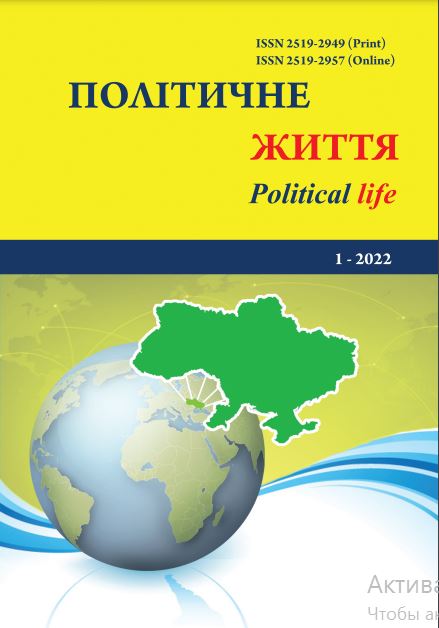Understanding International Relations after the end of the cold war: the trap of achistoricism.
DOI:
https://doi.org/10.31558/2519-2949.2022.1.15Keywords:
ahistoricism; historical analogy; cold war; new cold war; international relations; social nature of the subjectAbstract
The radical transformation of world politics has led to an active rethinking of practice and the theory of international relations. The situation is significantly complicated by the fact that historical parallels are most often used to justify or justify specific political decisions. Turning to the answers to History on the problems of modernity without proper methodological guidelines increases the risk of replacing the systematic reconceptualization of the nature of international relations with repeated "plastic surgery" of outdated theoretical approaches. The primary methodological source of substituting reconceptualization for "conceptual plastic surgery" is ahistoricism, the critical feature of which is the tendency to define and apply universal laws of historical development, unchanging characteristics of historical phenomena, whose nature depends little on the impact of specific historical circumstances.
The purpose of the study is to reveal the essence and consequences of the influence of ahistoricism on the understanding of international relations after the end of the Cold War. Its achievement is expected through the implementation of three research objectives: assessment of the analytical potential of the method of historical analogy; consideration of the case of the concept of "new cold war" and substantiation of its ahistorical methodological origins; proposals for a theoretical alternative to ahistoricism in the study of the modern world order, which is based on the methodological principle of historicism.
The autonomy of the two functions of the method of historical analogy (evidence and heuristic), the emphasis on the heuristic function, helps avoid the "trap of ahistoricism". Conclusions of the study: the effectiveness of the method of historical analogy in the study of international relations depends on a correct analysis of the nature of the compared phenomena and the whole set of factors influencing their behaviour and the state of the international system; the case of the "new cold war" is a convincing illustration of the "trap of historicism" in the understanding of international relations; analytical productivity of Cold War concepts is minimal, understanding modern world politics requires careful study of all dimensions of the historical context and social nature of the subjects, which requires updating methodological approaches.
References
Allison G. Destined for War: Can America and China Escape Thucydides’s Trap? Houghton Mifflin Harcourt, 2017. 384 p.
Anonymous. The Longer Telegram: Toward A New American China Strategy. Washington, DC: Atlantic Council. Scowcroft Center for Strategy and Security, 2021. 85 p.
Brands H., Gaddis J.L. The New Cold War. Foreign Affairs. 2021. Vol. 100. № 6. P. 10-20.
Breuning M. The Role of Analogies and Abstract Reasoning in Decision-Making: Evidence from the Debate over Truman’s Proposal for Development Assistance. International Studies Quarterly. 2003. Vol. 47. № 2. P. 229–245.
Buzan B., Little R. International Systems in World History: Remaking the Study of International Relations. Oxford University Press, 2000. 472 p.
Gardner H. IR Theory, Historical Analogy, and Major Power War. Palgrave MacMillan, 2019. 353 p.
Gordon P. E. Why Historical Analogy Matters. URL: https://www.nybooks.com/daily/2020/01/07/ why-historical-analogy-matters/ (дата звернення: 23.05.2020)
Hobson J., Lawson G. What is History in International Relations? Millennium: Journal of International Studies. 2008. Vol. 37. № 2. Р. 415–435.
Jervis R. Perception and Misperception in International Politics. Princeton and Oxford: Princeton University Press, 2017. 544 p.
Kornprobst M. Comparing Apples and Oranges? Leading and Misleading Uses of Historical Analogies. Millennium: Journal of International Studies. 2007. Vol. 36. № 1. Р. 29-49
Lucas E. The New Cold War: Putin’s Russia and the Threat to the West. Palgrave Macmillan, 2009. 288 p.
Mandelbaum M. The New Containment. Handling Russia, China, and Iran. Foreign Affairs. 2019. Vol. 98. № 2. P. 123-131.
Neustadt R.E. Thinking In Time. The Uses Of History For Decision-Makers. New York: The Free Press, 1988. 350 p.
Popper K. The poverty of historicism. New York and Evanston: Harper Torchbooks, 1961. 176 р.
Smith T. History and International Relations. New York: Routledge, 2005. 240 p.
Temirov Y. The West’s confusion: origins and implications. Social Space. Scientific Journal. 2018. 1 (15). P. 221-237.
X. The Sources of Soviet Conduct. Foreign Affairs. 1947. Vol. 25. № 4. Р. 566-582.
Walt S. I Knew the Cold War. This Is No Cold War. URL: https://foreignpolicy.com/2018/03/12/i-knewthe-cold-war-this-is-no-cold-war/ (дата звернення: 13.03.2018)
Wang Z. The Dangers of History Analogies. The Diplomat. https://thediplomat.com/2014/07/the-dangersof-history-analogies/ (дата звернення:)
Westad O.A. Has a New Cold War Really Begun? URL: https://www.foreignaffairs.com/articles/china/ 2018-03-27/has-new-coldwar-really-begun (дата звернення: 01.04.2018)

